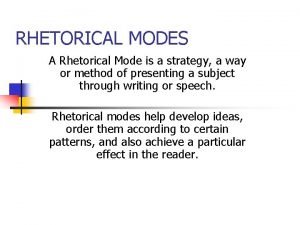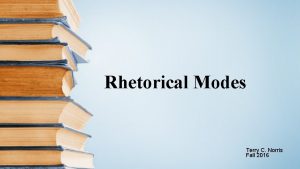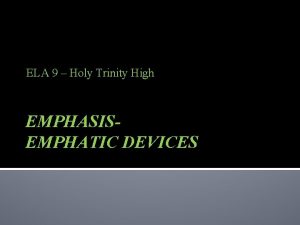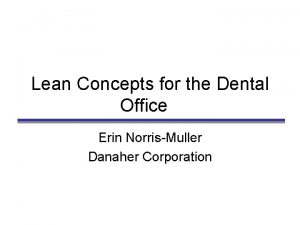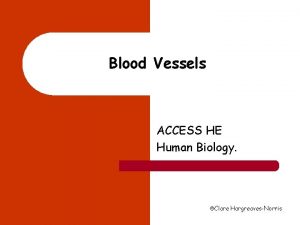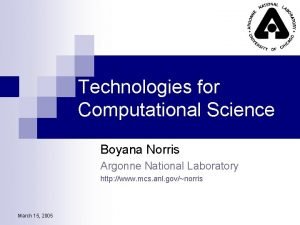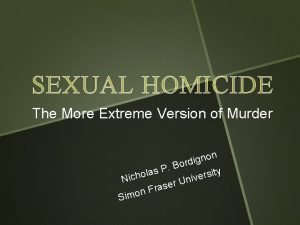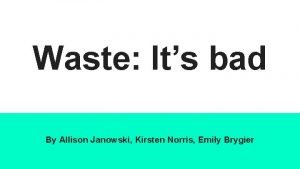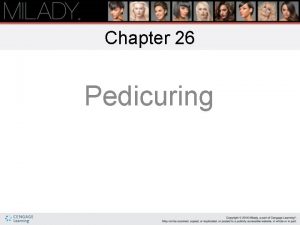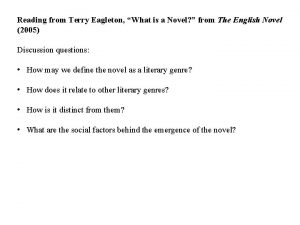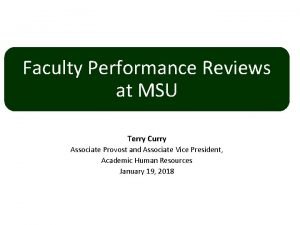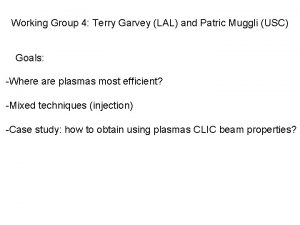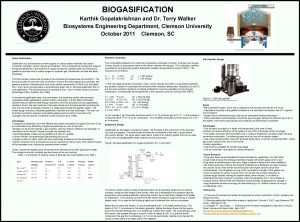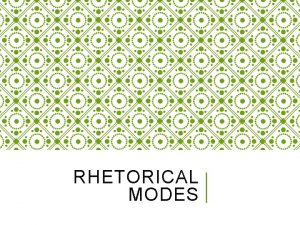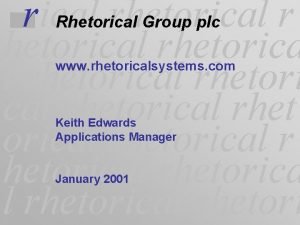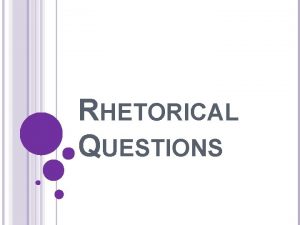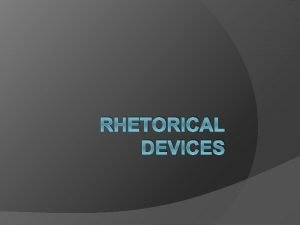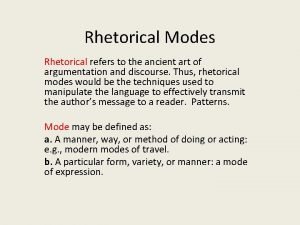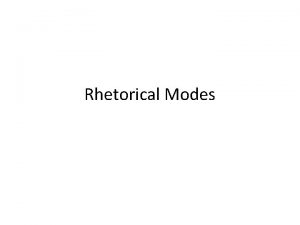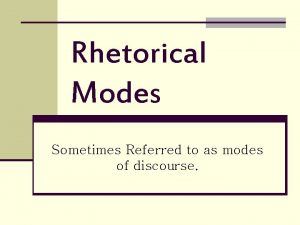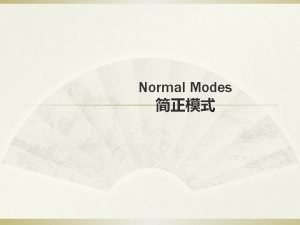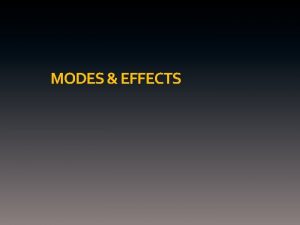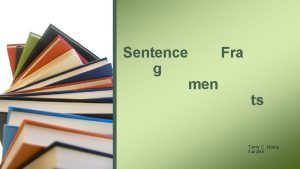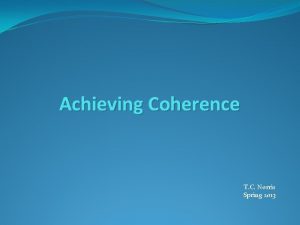Rhetorical Modes Terry C Norris Fall 2016 Definitions


























- Slides: 26

Rhetorical Modes Terry C. Norris Fall 2016

Definitions

Rhetoric: 1. The study of the elements used in literature and public speaking, such as content, structure, cadence, and style. 2. The art of prose as distinct from poetry. 3. a. Affectation or exaggeration in prose or verse. Unsupported or inflated discourse. b. 4. The art of oratory, especially the persuasive use of language to influence thoughts and actions of listeners. Rhetorical: 1. Concerned primarily with style or effect; showy, overelaborate. The American Heritage Dictionary of the English Language. Edited by William Morris. Boston, Houghton Mifflin, 1976.

Application for Writing Choosing the right • words • phrasing • format to clarify the point and influence the reader: “What is the best way to say this to get my point across? ”

Explanation

Modes – defined by the main points Exemplification – examples * Cause/Effect – reasons * Division/Classification – groups Process – steps * Comparison/Contrast – similarities and differences * Narration – story * Definition – new meaning for an old term Argumentation – proof * Research – verification *

Exemplification – examples The Concept 1. Purpose – clarify the point of thesis by giving examples of it. 2. Structure – main points are examples. a. Thesis – Three of my possessions that illustrate the principle of entropy are my car, my house, and my computer b. Topic sentences – One of my possessions that shows entropy is my car.

Exemplification – examples The Precaution Establish examples or items as main points, not reasons. This is a “what” essay, not a “why” essay.

Cause/Effect – reasons The Concept 1. Purpose – show a causal relationship between things. a. Several causes for one effect b. One cause for several effects c. One effect of several causes d. Several effects of one cause 2. Structure – main points are causes or effects. a. Thesis – Three causes of illegal drug use are peer pressure, stress, and curiosity. Or – Three effects of stress are illegal drug use, abusive behavior, and cheating in school. a. Topic sentences – The first cause of illegal drug use is peer pressure. Or – The first effect of stress is illegal drug use.

Cause/Effect – reasons The Precaution Many students begin by focusing on causes for certain effects, but in the body paragraphs, discuss effects of the effect that the topic sentence introduces. That is, they change the effects to causes. For example, they may focus on causes of illegal drug use, but in the body paragraphs, discuss the effects of illegal drug use. Instead of exploring the particular cause in that paragraph, they have changed the original effect into a cause.

Division/Classification – groups The Concept 1. Purpose – divide a topic into its various parts and group those parts into categories according to a principle of division – something they all have in common but express differently. 2. Structure – main points are groups. a. Thesis – Three kinds of friends, based on attitude, are happy friends, sad friends, and angry friends. b. Topic sentences – The first kind of friend based on attitude is the happy friend.

Division/Classification – groups The Precaution It is important to establish groups that are consistent with the principle of division. For example, it would not be consistent to have one group of friends who are happy, another group who drive sport cars, and another group who are tall. Those are certainly groups, but they represent three principles of division and belong in three different essays.

Process – steps The Concept 1. Purpose – explain the sequential steps involved in accomplishing something. 2. Structure – main points are steps in a process. a. Thesis – In order to stop a roof from leaking, first, clean all of the debris off of the roof; then find the leak; finally patch the leak with a good roofing sealer. b. Topic sentences – The first step in stopping a roof from leaking is to clean the roof thoroughly.

Process – steps The Precaution It is important to establish steps in the introduction and maintain that focus throughout the essay. Students have the tendency to discuss things that must be done to accomplish something, but they do not have to be done in sequence; often, they discuss things that must be repeated or must be done at the same time. For example, improving performance in a sport requires consistent exercise, eating a proper diet, and getting enough sleep; however, these things are not done in sequence but continually.

Comparison/Contrast – similarities and differences The Concept 1. Purpose – show two topics are either similar (comparison) or different (contrast) in significant ways. 2. Structure – main points areas of similarity or difference. a. Thesis – Rick and Captain Renault express nobility differently in character, goals, and treatment of others. b. Topic sentences – One way in which Rick and Captain Renault express nobility differently is in their character.

Comparison/Contrast – similarities and differences The Precaution It is important to establish two topics and clarify the similarities or differences throughout the essay. Comparison and contrast is very similar to exemplification, except that there are two topics rather than one. Students have the tendency to focus on one side or the other in topic sentences rather than addressing both topics. Formatting is also complicated in comparison/contrast essays. Usually, there are two formats to choose from: side-by-side and point-by-point. However, teachers may have their own variations on these two. Teachers may also require students to discuss either similarities or differences, but not both. Some may want students to include both.

Narration – story The Concept 1. Purpose – describe in sensory detail (sight, sound, taste, touch, smell, and emotions) and chronological order an experience that illustrates the point of the essay. Make the readers feel as though they are going through the same experience. 2. Structure – main points are parts of the experience. a. Thesis – Lighting a match, starting a fire, and trying to put out the fire taught me while I was still young the importance of knowing my limitations. b. Topic sentences – Lighting a match was the first thing that made me begin to consider my limitations. c. The bulk of the body paragraph will be the narrative of the experience.

Narration – story The Precaution Since narratives depend on specific detail to make them effective, their scope must be limited to a short period of time—usually no more than 24 hours. Beyond that, the writer starts reporting what happened rather than describing it as it happened. If the writer must discuss an experience that took an extended period of time, he should give an overview of the experience in the introduction and select the key parts of the experience to describe in the body paragraphs. Also, the writer should select just the details that contribute to the point of the essay; describing everything that happened is distracting and impossible.

Definition – new meaning for an old word The Concept 1. Purpose – explain a new, perhaps unusual, definition of a familiar term. 2. Structure – main points areas in which the new definition can be applied. a. Thesis – The team player attitude can be seen in business, school, and families. b. Topic sentences – The first area in which the team player attitude is seen is business.

Definition – new meaning for an old word The Precaution Most students have trouble getting past the standard definition; that is what the word means, and they can’t imagine another way to define it. They may come up with variations of the basic meaning but can’t think of new definitions or new contexts in which to use the term.

Argumentation – proof The Concept 1. Purpose – show through evidence presented in valid arguments that one’s position on a controversial issue is the strongest position. 2. Structure – main points are arguments that support the assertion in thesis. a. Thesis – Although many people think that theory of evolution is scientific, it can’t be scientific because it contradicts natural law, is based on assumptions, and, in essence, is religious. b. Topic sentences – The first reason that theory of evolution cannot be scientific is that it contradicts natural law.

Argumentation – proof The Precaution Students tend to focus on facts in both thesis and topic sentences. They need to start with a controversial issue (room for a difference of opinion), establish a position (“should/should not”) in thesis, and provide arguments or reasons for that position as the main points. Basically, focus on these things: - Controversial issue (room for a difference of opinion) - Position (a specific opinion that someone could disagree with) - Valid arguments/reasons that support the position (not statements of fact) - Examples and evidence that “prove” the position (no fallacies)

Research – verification The Concept 1. Purpose – use reliable outside sources to support the points. a. argumentative – show that your position on an issue is supported by experts in the field. b. informative – provide authoritative information to clarify an issue. 2. Structure – main points are a. arguments, for an argumentative research paper. b. points of clarification, for an informative research paper. c. Thesis – Although many people think that theory of evolution is scientific, it can’t be scientific because it contradicts natural law, is based on assumptions, and, in essence, is religious. d. Topic sentences – The first reason that theory of evolution cannot be scientific is that it contradicts natural law.

Research – verification The Precaution All the things that apply to an argumentative paper apply to an argumentative research paper. The difference is that a research paper depends on reliable outside sources to support the points. The same is true for an informative research paper. Be careful of the following: 1. Make sure that the sources cited in the paper are really authoritative; using weak sources weakens the paper. 2. Be sure to incorporate the information you borrow into your paper correctly. 3. Be sure to give credit to the sources from which you borrow information – avoid plagiarism. 4. Be sure to use the appropriate documentation style for the assignment (MLA, APA, etc. ) and to follow the format correctly

Summary

Application for Writing Among the skills necessary for effective writing is the ability to choose the right rhetorical mode for the topic and purpose of the writing. The topic and purpose dictate which rhetorical mode would be best: – Showing how two things are similar or different obviously requires the comparison/contrast mode. – Explaining how to do something requires the process mode. – etc. The modes may overlap: – No matter which mode you use, you will have to provide examples, but this does not make the essay an exemplification essay. – If you compare/contrast two processes, the topics will be processes, but it will still be a comparison/contrast essay. Remember the basic question: “What is the best way to say this to get my point across? ”
 Rhetorical modes examples
Rhetorical modes examples Six example of rhetorical patterns
Six example of rhetorical patterns Define rhetorical modes
Define rhetorical modes Rhetorical trinity
Rhetorical trinity Dr erin norris
Dr erin norris Largest vein in the body
Largest vein in the body Pippa norris digital divide
Pippa norris digital divide Boyana norris
Boyana norris Tami wall
Tami wall Norris krueger
Norris krueger Lawrence bittaker and roy norris polaroids
Lawrence bittaker and roy norris polaroids Uwm norris health center
Uwm norris health center Norris conference center houston
Norris conference center houston Allison janowski
Allison janowski Hss hypersonic sound
Hss hypersonic sound Peter norris ysu
Peter norris ysu Free fall 2016
Free fall 2016 Dr terry kwan
Dr terry kwan Name 5 pieces of equipment unique to pedicures
Name 5 pieces of equipment unique to pedicures Terry eagleton football
Terry eagleton football Terry eagleton what is a novel
Terry eagleton what is a novel Spraggins fitness
Spraggins fitness Terry stop
Terry stop Terry curry msu
Terry curry msu Terry garvey
Terry garvey Dasar dasar pengambilan keputusan menurut george r terry
Dasar dasar pengambilan keputusan menurut george r terry Karthik gopalakrishnan
Karthik gopalakrishnan
